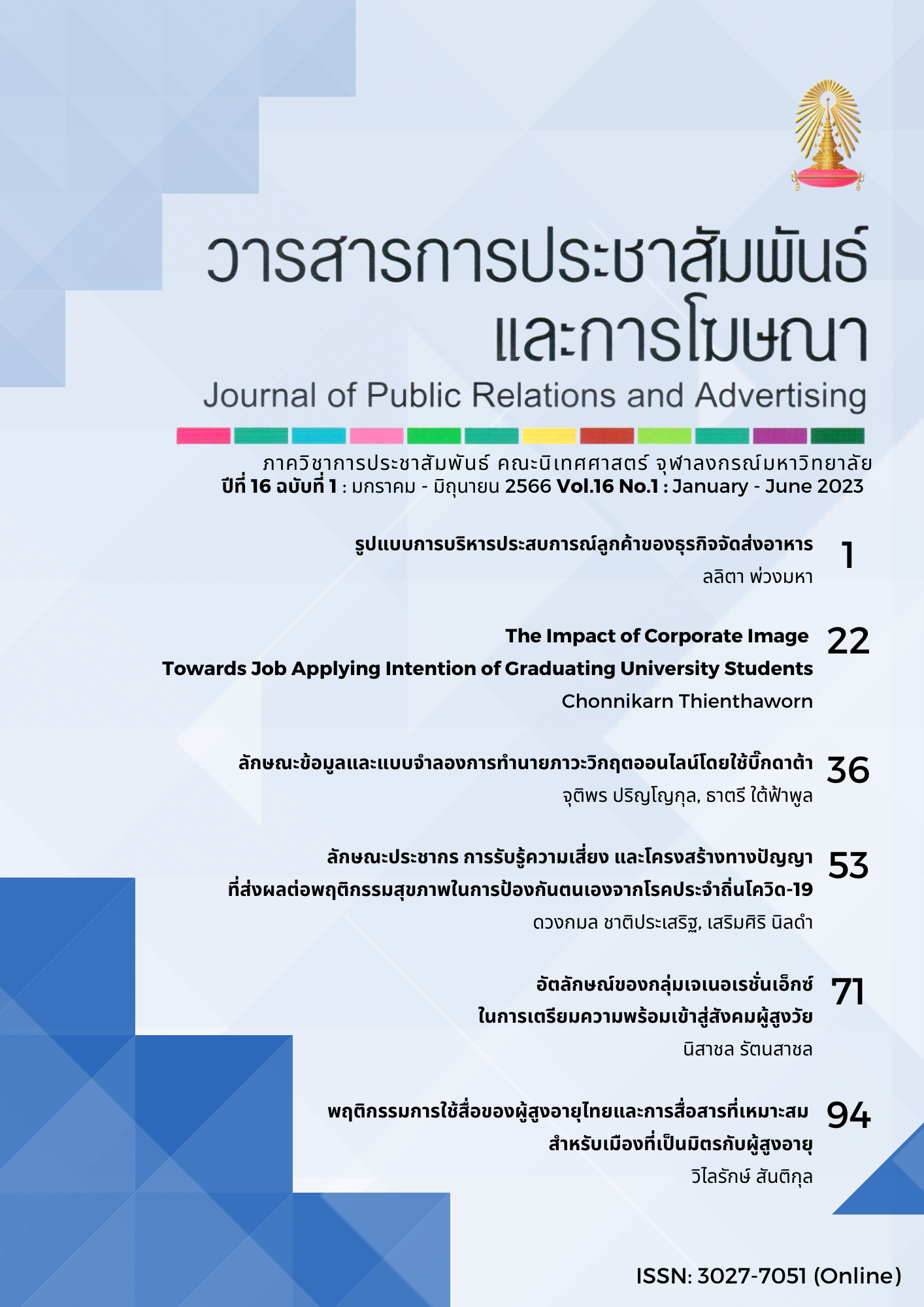Model of Customer Experience Management in Food Delivery Businesses
Main Article Content
Abstract
T
This research employs a mixed-method study using a convergent parallel design. The objective is to develop and investigate the empirical consistency of the customer experience management structural equation model that affects customer satisfaction and customer loyalty in food delivery businesses. A questionnaire was utilized to collect data from 385 Bangkok-based customers of food delivery businesses, with an age range of 18-65 years old. In addition, in-depth interviews were conducted with twenty key informants, including food delivery business customers, food delivery business owners, and a group of online marketing communication specialists, to examine the customer experience management model of food delivery businesses.
According to the findings of the quantitative study, the researcher’s customer experience management structural equation model that influences customer satisfaction and loyalty in the food delivery businesses is compatible with the empirical data (model fit) at the statistical significance level of 0.05. The customer experience management variable had a statistically significant direct influence on customer satisfaction at the 0.01 level, a statistically significant direct influence on customer loyalty at the 0.05 level, and a statistically significant indirect influence on customer loyalty via the path of customer satisfaction at the 0.01 level. The results of the qualitative research showed that the customer experience management model for food delivery businesses consists of nine key components: product offer, brand communication, security and privacy, application design, delivery, product quality, customer service, special offer, and interactivity.
Article Details
References
กัลยา วานิชย์บัญชา. (2557). การวิเคราะห์สมการโครงสร้าง (SEM) ด้วย AMOS (พิมพ์ครั้งที่ 2). กรุงเทพมหานคร: ห้างหุ้นส่วนจำกัดสามลดา.
เกียรติสุดา ศรีสุข. (2552). ระเบียบวิธีวิจัย. เชียงใหม่: โรงพิมพ์ครองช่าง.
ชเนศ ลักษณ์พันธุ์ภักดี. (2560). ปัจจัยที่มีอิทธิพลต่อการตัดสินใจใช้บริการสั่งอาหารแบบเดลิเวอรี่ผ่านสื่ออิเล็กทรอนิกส์ในเขตกรุงเทพมหานครและปริมณฑล (วิทยานิพนธ์ปริญญามหาบัณฑิต). กรุงเทพมหานคร: มหาวิทยาลัยธรรมศาสตร์.
ณัฐพัชร์ ล้อประดิษฐ์พงษ์. (2549). คู่มือสำรวจความพึงพอใจลูกค้า. กรุงเทพมหานคร: ประชุมทอง พริ้นติ้ง กรุ๊ป.
ณัฐรุจา พงศ์สุพัฒน์. (2561). การศึกษาตลาดแอปพลิเคชันอาหารและพฤติกรรมผู้บริโภคต่อการตัดสินใจเลือกใช้บริการแอปพลิเคชันอาหาร (วิทยานิพนธ์ปริญญามหาบัณฑิต). กรุงเทพมหานคร: มหาวิทยาลัยธรรมศาสตร์.
นฤวรรณ ตั้งกิจทนงศักดิ์. (2560). ปัจจัยที่มีอิทธิพลต่อการใช้บริการสั่งอาหารเดลิเวอรี่ผ่านแอปพลิเคชันของกลุ่มเจเนอเรชันวายในเขตกรุงเทพมหานคร (วิทยานิพนธ์ปริญญามหาบัณฑิต). กรุงเทพมหานคร: มหาวิทยาลัยศิลปากร.
ปณชัย อารีเพิ่มพร. (2563). ผ่าสังเวียนศึก “ฟู้ดเดลิเวอรีไทย” เมื่อโจทย์ใหญ่ในจานอร่อยคือต้อง “ทำเงิน” ด้วย. วันที่เข้าถึงข้อมูล 12 ธันวาคม 2563, แหล่งที่มา https://thestandard.co/thai-food-delivery-business/
ปิยะฉัตร ปวงนิยม และเทิดชาย ช่วยบำรุง. (2564). ความสัมพันธ์เชิงสาเหตุของการจัดการประสบการณ์ในร้านสปา คุณภาพการบริการของร้านสปา และความพึงพอใจของลูกค้าที่ส่งผลต่อความภักดีของผู้ใช้บริการเดย์สปาในเขตกรุงเทพมหานคร. วารสารธุรกิจปริทัศน์, 13(2), 286-304.
ปิยะชาติ อิศรภักดี. (2559). Branding 4.0 (พิมพ์ครั้งที่ 6). กรุงเทพมหานคร: อมรินทร์พริ้นติ้งแอนด์พับลิชชิ่ง.
พิมพงา วีระโยธิน. (2560). ปัจจัยที่ส่งผลให้ผู้บริโภคตัดสินใจใช้แอปพลิเคชันอูเบอร์ อีท (Uber Eats) เพื่อบริการรับส่งอาหาร (food delivery) (วิทยานิพนธ์ปริญญามหาบัณฑิต). กรุงเทพมหานคร: มหาวิทยาลัยกรุงเทพ.
พิมพุมผกา บุญธนาพีรัชต์. (2560). ปัจจัยส่วนประสมทางการตลาดที่มีผลต่อการตัดสินใจใช้บริการ Food Delivery ในเขตกรุงเทพมหานครและปริมณฑล (วิทยานิพนธ์ปริญญามหาบัณฑิต). กรุงเทพมหานคร:มหาวิทยาลัยธรรมศาสตร์.
พิรานันท์ แกล่งกล้า. (2562). การวิเคราะห์คุณลักษณะของบริการแอปพลิเคชันเพื่อการสั่งอาหารเดลิเวอรี่ในกรุงเทพมหานคร (วิทยานิพนธ์ปริญญามหาบัณฑิต). กรุงเทพมหานคร: มหาวิทยาลัยเกษตรศาสตร์.
พีรพงศ์ แท่นวิทยานนท์, เกศรา สุกเพชร, และโชคชัย สุเวชวัฒนกูล. (2562). การบริหารประสบการณ์ลูกค้า คุณค่า และความพึงพอใจลูกค้าในธุรกิจท่องเที่ยวต่างประเทศ: ความสัมพันธ์เชิงทฤษฎี. วารสารวิทยาลัยดุสิตธานี, 13(1), 107-122.
พูลพงศ์ สุขสว่าง. (2556). โมเดลสมการโครงสร้าง. กรุงเทพมหานคร: วัฒนาพานิช.
แพน จรุงธนาภิบาล. รองผู้อำนวยการแผนกพัฒนาและการตลาด บริษัท กรุ๊ปเอ็ม (ประเทศไทย) จำกัด (1 พฤศจิกายน 2564). สัมภาษณ์.
ยุทธ ไกยวรรณ์. (2556). การวิเคราะห์โมเดลสมการโครงสร้างด้วย AMOS. กรุงเทพมหานคร: จุฬาลงกรณ์มหาวิทยาลัย.
ลลิตา พ่วงมหา. (2564). แนวทางการบริหารประสบการณ์ลูกค้าด้วยเทคโนโลยีเสมือนจริง. วารสารนิเทศศาสตร์, 39(3), 113-123.
สลิลาทิพย์ ทิพยไกรศร. (2564). ความสััมพัันธ์์เชิิงสาเหตุุระหว่างการบริหารประสบการณ์์ของลููกค้า ความพึงพอใจของลููกค้า ความจงรักภัักดีี และการบอกต่อในธุรกิจค้าปลีกออนไลน์. วารสารวิชาการบริหารธุรกิจ, 10(1), 198-213.
สุภมาส อังศุโชติ, สมถวิล วิจิตรวรรณา, และรัชนีกูล ภิญโญภานุวัฒน์. (2554). สถิติวิเคราะห์สำหรับการวิจัยทางสังคมศาสตร์และพฤติกรรมศาสตร์: เทคนิคการใช้โปรแกรม LISREL (พิมพ์ครั้งที่ 3). กรุงเทพมหานคร: เจริญดีมั่นคงการพิมพ์.
เสริมยศ ธรรมรักษ์. หัวหน้าภาควิชาการสื่อสารแบรนด์ และอาจารย์ประจำคณะนิเทศศาสตร์ มหาวิทยาลัยกรุงเทพ (13 ตุลาคม 2564). สัมภาษณ์.
สำนักงานคณะกรรมการแข่งขันทางการค้า. (2564). เปิดพฤติกรรมการแข่งขันในธุรกิจให้บริการส่งอาหาร. วันที่เข้าถึงข้อมูล 8 สิงหาคม 2564, แหล่งที่มา https://www.caat.or.th/wp-content/uploads/2020/11.pdf
อรวรรณ สุทธิพงศ์สกุล และสมชาย เล็กเจริญ. (2563). อิทธิพลของประสบการณ์และความพึงพอใจที่มีผลต่อความภักดีและการสื่อสารแบบปากต่อปากทางอิเล็กทรอนิกส์ในการซื้อสินค้าผ่านแอปพลิเคชันของผู้บริโภคในเขตกรุงเทพมหานครและปริมณฑล. วารสารการประชาสัมพันธ์และการโฆษณา, 13(2), 100-112.
Camelia, B., & Lia, B. (2013). The value of brand equity. Procedia Economics and Finance, 6(1), 444-448.
Chai, L. T., & Yat, D. N. C. (2019). Online food delivery services: Making food delivery the new normal. Journal of Marketing Advances and Practices, 1(1), 62-77.
Fouladivanda, F, Khanmohammadi, Z., Hooman, A., & Rajabinasr, A. (2013). The relationship between customer experience and service quality. Interdisciplinary Journal of Contemporary Research in Business, 4(9), 316-330.
Gronroos, C., & Voima, P. (2013). Critical service logic: Making sense of value creation and co-creation. Journal of the Academy of Marketing Science, 41(2), 133-150.
Ha, M. T. (2021). The impact of customer experience on customer satisfaction and customer loyalty. Turkish Journal of Computer and Mathematics Education, 12(14), 1027-1038.
Kotler, P., Kartajaya, H., & Setiawan, I. (2021). Marketing 5.0: Technology for humanity. New Jersey: John Wiley and Sons.
Limsarun, T., Navavongsathian, A., Vongchavalitkul, B., & Damrongpong, N. (2021). Factors affecting consumer’s loyalty in food delivery application service in Thailand. Journal of Asian Finance, Economics and Business, 8(2), 1025-1032.
Napitupulu, T. A., & Aditomo, H. C. (2015). Factors affecting customer loyalty in business
e-commerce: A case of Indonesia. Journal of Theoretical and Applied Information Technology, 76(3), 386-392.
Oliver, R. L. (1997). Whence customer loyalty?. Journal of Marketing, 12(2), 33-44.
Puangmaha, L. (2017). The causal model of factors affecting Thai customer loyalty towards e-commerce business (Doctoral dissertation). National Institute of Development Administration, Bangkok.
Rolland, S., & Freeman, I. (2010). A new measure of e-service quality in France. International Journal of Retail & Distribution Management, 38(7), 497-517.
Saarijarvi, H., Kannan, P. K., & Kuusela, H. (2013). Value co-creation: Theoretical approaches and practical implications. European Business Review, 25(1), 6-19.
Sashi, C. M. (2012). Customer engagement, buyer-seller relationships, and social media. Management Decision, 50(2), 253-272.
Schiffman, L., & Kanuk, L. (2007). Consumer Behavior (9th ed.). New Jersey: Prentice Hill.
Shaw, C., & Ivens, J. (2002). Building Great Customer Experience. New York: Palgrave Macmillan.
Vakeel, K. A., Das, S., Udo, G. J., & Bagchi, K. (2017). Do security and privacy policies in B2B and B2C e-commerce differ? A comparative study using content analysis. Behaviour & Information Technology, 36(4), 390-403.
Wolfinbarger, M., & Gilly, M. C. (2003). etailQ: Dimensionalizing, measuring and predicting etail quality. Journal of Retailing, 79(3), 183-198.
Wu, Y. C., Shen, J. P., & Chang, C. L. (2015). Electronic service quality of Facebook social commerce and collaborative learning. Computers in Human Behavior, 51, 1395-1402.
Zeithaml, V. A., Parasuraman, A., & Malhotra, A. (2002). Service quality delivery through web sites: A critical review of extant knowledge. Journal of the Academy of Marketing Science, 30(4), 362-375.


